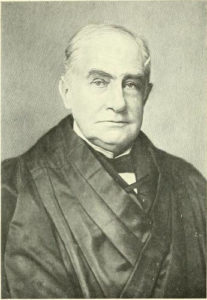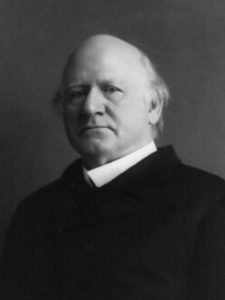L’arrêt Plessy v. Ferguson du 18 mai 1896 (III) : la validation de la ségrégation par la Cour Suprême des Etats-Unis
Pour assurer la défense d’Homer Plessy devant la Cour suprême des Etats-Unis, Albion W. Tourgée fait appel à un ami avocat à Washington, Samuel F. Phillips [1]. Après trois ans d’attente, l’audience de plaidoirie se tient le 13 avril 1896 et la décision est rendue le 18 mai 1896 [2]. La Cour suprême juge à une majorité de sept contre un le « Separate Car Act » conforme à la constitution américaine. L’opinion majoritaire est écrite par le juge Henry Billings Brown, originaire du Massachusetts et l’opinion dissidente par le juge John Marshall Harlan, seul sudiste de la composition et fils d’esclavagiste [3].

Le juge Brown écarte très vite dans sa motivation une inconstitutionnalité du « Separate Car Act » par rapport au treizième amendement à la constitution, qui abolit l’esclavage [4]. Il écarte également toute violation du quatorzième amendement à la constitution. S’il reconnaît que le quatorzième amendement vise à assurer l’égalité juridique des citoyens devant la loi, il considère que celui-ci n’a pas vocation à faire disparaître les différences fondées sur la couleur de la peau, à garantir une égalité sociale ou un « mélange des deux races » dans des conditions insatisfaisantes pour chacune [5].
Selon l’opinion majoritaire, la séparation des citoyens dans les transports ferroviaires en fonction de leur couleur de peau ne marque pas une infériorité particulière d’une race par rapport à une autre [6]. Le juge Brown relève que chaque passager, quel que soit le wagon où il est affecté, bénéficie de prestations de même qualité [7]. Il qualifie donc le « Separate Car Act » de « loi raisonnable » fondée sur des usages et coutumes du peuple, et visant à favoriser le confort de chacun et le maintien de la tranquillité publique [8]. C’est cette position (« séparé mais égaux ») qui va permettre de valider pendant des dizaines d’années la ségrégation aux Etats-Unis.

John Marshall Harlan est le seul juge à s’opposer à cette décision. Pour lui, le « Separate Car Act » a pour conséquence de restreindre la liberté des citoyens de se déplacer comme ils le souhaitent. Il rappelle que la constitution américaine ne fait aucune distinction entre les citoyens en fonction de leur couleur de peau ou de leur classe sociale, et exclut la possibilité de castes [9]. La séparation évoquée implique à son sens de manière claire une discrimination raciale. Il souligne d’ailleurs que l’objectif du « Separate Car Act » n’est pas tant d’exclure les blancs des wagons réservés aux noirs que d’exclure les noirs des wagons réservés aux blancs. Il évoque le risque que ce type de séparation s’étende à d’autres lieux, comme les rues dont un côté serait réservé aux personnes blanches et l’autre aux personnes noires mais aussi à d’autres types de discriminations (citoyens américains natifs par rapport aux citoyens américains naturalisés, citoyens protestants par rapport aux citoyens catholiques) [10].
Lorsqu’elle est rendue, cette décision n’est pas une surprise. Elle valide une ségrégation qui est largement acceptée, et considérée, selon les termes du juge Brown, comme étant « dans dans la nature des choses » [11]. Les arguments développés dans l’opinion majoritaire reposent sur des préjugés racistes partagés par une grande partie de la société. Il faudra attendre 1954 pour voir un revirement de la Cour suprême des Etats-Unis concernant la question de la ségrégation raciale. Dans l’arrêt Brown v. Board of Education du 17 mai 1954, elle revient sur la doctrine « séparés, mais égaux » et déclare la ségrégation raciale des établissements scolaires contraire au quatorzième amendement de la constitution [12].
1. [↑] Voir l’ouvrage « Separate: The Story of Plessy v. Ferguson, and America’s Journey from Slavery to Segregation« , de Steve Luxenberg, 2019, chapitre 21.
2. [↑] Voir la page consacrée à l’arrêt Plessy v. Ferguson sur le site oyez.org.
3. [↑] Voir Steve Luxenberg, 2019, chapitre 22 : « The Southerner, the son of a Kentucky slaveholder, saw the case in a practical and historical context that none of his Northern colleagues seemed to grasp. “In my opinion », he wrote, “the judgment this day rendered will, in time, prove to be quite as pernicious as the decision made by this tribunal in the Dred Scott Case.” ; l’article The Constitution, Civil Liberties and John Marshall Harlan, de Florian Bartosic, Kentucky Law Journal, 1958, volume 46, numéro 3, page 422 : « All the Justices on the Court except Harlan were either born in the North or appointed to the bench from that part of the country. An ex-slave-owner, who had at one time protested against the abolition of slavery by federal authority, he alone dissented, and he did so with both indignation and eloquence« .
4. [↑] Voir le détail sur l’arrêt Plessy v. Ferguson sur le site Legal Information Institute (LII).
5. [↑] Voir l’arrêt Plessy v. Ferguson : « The object of the amendment was undoubtedly to enforce the absolute equality of the two races before the law, but, in the nature of things, it could not have been intended to abolish distinctions based upon color, or to enforce social, as distinguish d from political, equality, or a commingling of the two races upon terms unsatisfactory to either« .
6. [↑] Voir l’arrêt Plessy v. Ferguson : « We consider the u derlying fallacy of the plaintiff’s argument to consist in the assumption that the enforced separation of the two races stamps the colored race with a badge of inferiority ».
7. [↑] Voir l’arrêt Plessy v. Ferguson : « So, where the laws of a particular locality or the charter of a particular railway corporation has provided that no person shall be excluded from the cars on account of color, we have held that this meant that persons of color should travel in the same car as white ones, and that the enactment was not satisfied by the company providing cars assigned exclusively to people of color, though they were as good as those which they assigned exclusively to white persons. Railroad Co. v. Brown, 17 Wall. 445« .
8. [↑] Voir l’arrêt Plessy v. Ferguson : « In determining the question of reasonableness, it is at liberty to act with reference to the established usages, customs, and traditions of the people, and with a view to the promotion of their comfort, and the preservation of the public peace and good order. Gauged by this standard, we cannot say that a law which authorizes or even requires the separation of the two races in public conveyances is unreasonable« .
9. [↑] Voir l’arrêt Plessy v. Ferguson : « But in view of the constitution, in the eye of the law, there is in this country no superior, dominant, ruling class of citizens. There is no caste here. Our constitution is color-blind, and neither knows nor tolerates classes among citizens. In respect of civil rights, all citizens are equal before the law. The humblest is the peer of the most powerful. The law regards man as man, and takes no account of his surroundings or of his color when his civil rights as guarantied by the spreme law of the land are involved« .
10. [↑] Voir l’arrêt Plessy v. Ferguson : « If a state can prescribe, as a rule of civil conduct, that whites and blacks shall not travel as passengers in the same railroad coach, why may it not so regulate the use of the streets of its cities and towns as to compel white citizens to keep on one side of a street, and black citizens to keep on the other? Why may it not, upon like grounds, punish whites and blacks who ride together in street cars or in open vehicles on a public road or street? Why may it not require sheriffs to assign whites to one side of a court room, and blacks to the other? And why may it not also prohibit the commingling of the two races in the galleries of legislative halls or in public assemblages convened for the consideration of the political questions of the day? Further, if this statute of Louisiana is consistent with the personal liberty of citizens, why may not the state require the separation in railroad coaches of native and naturalized citizens of the United States, or of Protestants and Roman Catholics?« .
11. [↑] Voir l’arrêt Plessy v. Ferguson : « The object of the amendment was undoubtedly to enforce the absolute equality of the two races before the law, but, in the nature of things, it could not have been intended to abolish distinctions based upon color, or to enforce social, as distinguish d from political, equality, or a commingling of the two races upon terms unsatisfactory to either« .
12. [↑] Voir le détail sur l’arrêt Brown v. Board of Education sur le site Legal Information Institute (LII).